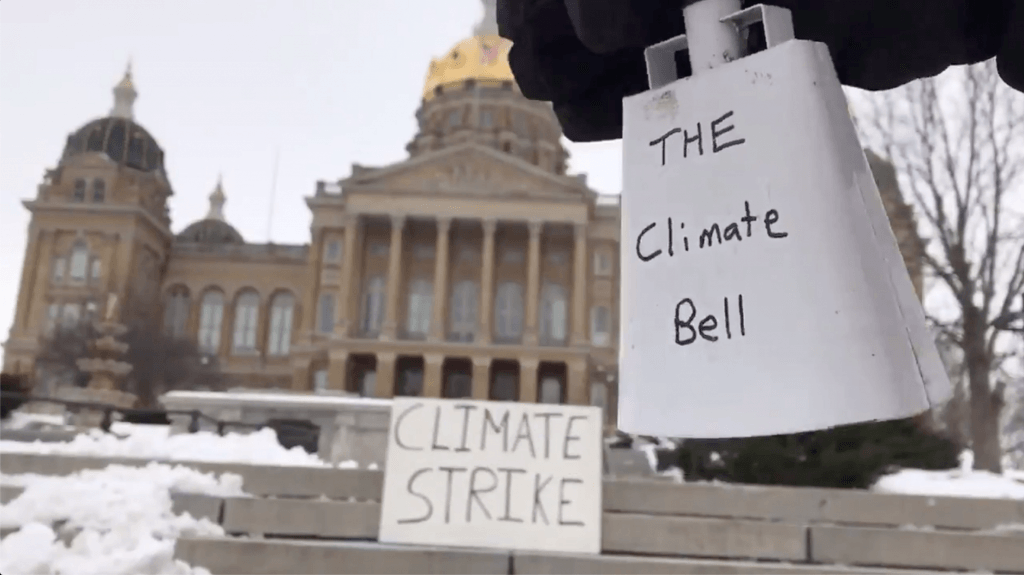For whom the climate bell tolls, at two minutes to noon
By Thomas Gaulkin | February 20, 2019
 Capture from Matthew Bailey @PlantSync
Capture from Matthew Bailey @PlantSync
Panic is in the air.
Speaking at the World Economic Forum in Davos a few weeks ago, 16-year-old climate activist Greta Thunberg told a room full of powerful adults, “I don’t want you to be hopeful. I want you to panic.” Aiming at scientists, journalists, and politicians in a recent piece for The New York Times, David Wallace-Wells wrote, “It is O.K., finally, to freak out. Even reasonable.”
In the aftermath of last year’s hurricanes, wildfires, and terrifying scientific reports, there seems to be new energy for public outrage about climate issues. Thunberg’s weekly school strike for climate has caught on worldwide, a global strike day is now planned for March 15, and Thunberg and her US counterparts are receiving increasingly high-profile media attention.
But most people don’t have access to that kind of platform for expressing their feelings on climate change (and may not even want it). So how do the rest of those hoping to sound the alarm about climate change make some noise?
One idea: Make noise. Literally.
Inspired by church bells ringing in Europe on the eve of the COP24 conference in Kratowice, Poland last December, Jonathan Bailey decided to make the idea more user (and social media) friendly. Bailey, who is active in the Portland, Oregon chapter of Al Gore’s Climate Reality Project, began ringing a bell every day and posting a video on Twitter with the hashtag #ringthebellforclimate.
https://twitter.com/climateunion/status/1073306163545075712
Bailey’s goal is to galvanize a global movement of regular people all ringing bells at two minutes to noon—a direct reference to the Bulletin’s famous Doomsday Clock, which is now set at two minutes to midnight. “Imagine a future when you can hear other bells ringing at this time,” says a call to action on his website.
“I decided 11:58 p.m. was maybe a little bit of a heavy ask. You know, there might be some complaints,” Bailey said. “Several neighbors have asked me what the hell I’m doing. I explain what it’s all about—I consider this an existential threat.”
https://twitter.com/climateunion/status/1090338314933231622
The idea of ringing bells for climate change is not new. In 2008, a minister from the Massachusetts Conference of the United Church of Christ appealed to a group of 400 churches to pick a day and ring their bells 350 times in reference to Bill McKibben’s climate project 350.org (named after a maximum-parts-per-million target of carbon dioxide in the atmosphere now long since passed).
McKibben himself endorsed the idea in a video ahead of an international bell-ringing event timed to coincide with the Copenhagen summit on climate change in December 2009. “Before we had radio and things, if somebody’s house caught on fire in town, we rang the church bell so everybody would know and come out to do something about it,” he said. “Well, something’s on fire now. That something is the planet.“
There are musical compositions that marry bell peals and climate threats too. A group of musicians in California created an interactive carillon concert in which the melody is generated in real-time from sea-level data. A German composer, Klaus Wüsthoff, premiered a symphony in January of last year featuring a carillon under the auspices of a group entirely devoted to the idea of “climate bells.”
https://www.facebook.com/TheGreenShift/videos/778525715828744
“The Final Countdown” performed on the Martinikerk carillon in Groningen, Netherlands. Hundreds of churches’ bells pealed December 1, 2018 to “sound the alarm” on climate before the COP24 climate conference in Kratowice, Poland.
Not everyone has a church bell available.
For what may have been the earliest organized ringing of bells for climate, a Northern Irish coalition of environmental and religious groups organized a nationwide event to “ring the changes” at the same time the December 2007 UN climate conference was beginning in Poznan, Poland. One of the event coordinators, Niall Bakewell, said at the time, “Because [St. Anne’s Cathedral in Belfast] doesn’t have any bells, we had to make our own ringing sounds. Around 100 people brought alarm clocks, mobile phones, drums, whistles, triangles and a vintage Glentoran corncrake!”
To encourage its spread, Bailey expanded the concept for #ringthebellforclimate to include any kind of noise-making too. “It can be pots and pans or whatever you want,” he said. “I’m waiting for an air-horn.”
Even drawings of bells are ok, said Bailey’s brother Matthew: “Basically, anything extra that someone does on a daily basis to bring attention to climate change is ‘ringing the bell for climate.’”
The Twitter account devoted to promoting the effort has retweeted videos and photos from England, Japan, Italy, and elsewhere. Among the most prolific and creative tweeters is Reece Benson, a young activist who seems to have an entire zoo’s worth of stuffed animals armed with bells and facts about climate change:
According to the UN about 2.4 billion people (almost 40 percent of the world's population) live within 100km of coasts. Seas are rising, so #ringthebellforclimate Change the tide! #FridaysForFuture #ClimateChange #ClimateStrike #PresidentsDay2019 pic.twitter.com/VhNRgXzDqH
— Reece Benson (@ReeceBenson5) February 19, 2019
Q: What happens when deniers force their anti #ClimateChange theories on oysters?
A: The arguments are expelled as pseudo-science!#ringthebellforclimate#ClimateStrike@zaynecowie@solo_syn@HollyWildChild@SophiaMathur@ClimateHuman@vanessadantes1@lillyspickup@FFF_USA pic.twitter.com/mcGm5SWjXP— Reece Benson (@ReeceBenson5) February 14, 2019
Members of climate strike groups like Fridays for Future and Extinction Rebellion, a new climate movement that originated in the UK, are also picking up “the climate bell,” Bailey said. But activists aren’t the only ones chiming in. Scientists from George Mason University’s Center for Climate Change Communication, including Bulletin columnist (and illustrator) John Cook, recently rang a bell for Presidents’ Day:
The Planets got a sickness and the only cure is more cow bell!
This year on Presidents Day we joined the movement to #RingTheBellForClimate!@MaibachEd @DrMonaS @climateunion pic.twitter.com/uh1D021OYP— GMU Center for Climate Change Communication (@Mason4C) February 20, 2019
https://www.instagram.com/p/BuCJXl1nLRu/
Publication Name: #ringthebellforclimate
To read what we're reading, click here
Together, we make the world safer.
The Bulletin elevates expert voices above the noise. But as an independent nonprofit organization, our operations depend on the support of readers like you. Help us continue to deliver quality journalism that holds leaders accountable. Your support of our work at any level is important. In return, we promise our coverage will be understandable, influential, vigilant, solution-oriented, and fair-minded. Together we can make a difference.
Topics: Climate Change, What We’re Reading














